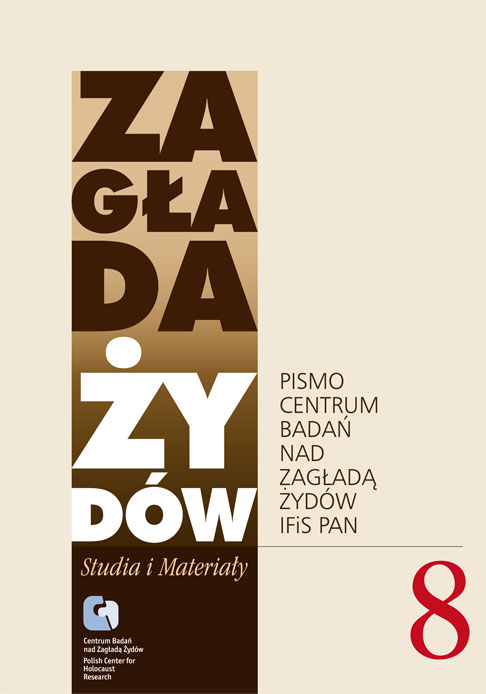Pogłoski w białostockim getcie. Przyczynek do historiografii Zagłady z perspektywy żydowskiej
Zagłada Żydów. Studia i Materiały, Nr 8 (2012), Strony: 214-236
Data zgłoszenia: 2020-10-28Data publikacji: 2012-12-02
 https://doi.org/10.32927/ZZSiM.633
https://doi.org/10.32927/ZZSiM.633
Abstrakt
The article deals with rumors, which were circulated in the Białystok ghetto. It seems that a rumor is a form of collective interpretation of reality whose function is to structure equivocal situations by explaining events or predicting them. The mood and behavior of individuals and groups may be influenced by rumors, in particular if they find themselves – as the Jews in the ghettos – in an exceptional and lifethreatening situation characterized by insecurity, isolation and uncertainty. The article analyzes rumors relating to the deportations of Jews from the ghetto and German mass murder actions. It addresses the following questions: Which impact did the different rumors have? How did the Judenrat and the ghetto population react to them? The article demonstrates that Jews acted upon their apprehension or misapprehension of events and that their subjective evaluation of the German extermination policy influenced their behavior and decisions
Słowa kluczowe
pogłoski , deportacje , niemiecka polityka eksterminacyjna , Judenrat , żydowska perspektywa i zachowania
Licencja
Prawa autorskie (c) 2012 Autor&"Zagłada Żydów. Studia i Materiały"

Utwór dostępny jest na licencji Creative Commons Uznanie autorstwa 4.0 Międzynarodowe.
https://creativecommons.org/licenses/by/4.0
Czasopismo publikowane jest w standardzie Diamond Open Access na licencji CC-BY-4.0 Deed - Uznanie autorstwa 4.0 Międzynarodowa - Creative Commons
Podobne artykuły
- Monika Polit, Jankiew Pat. „Żydowski brat z ziemi amerykańskiej, który jest też polskim Żydem” , Zagłada Żydów. Studia i Materiały: Nr 16 (2020)
- Marek Kornat, Papież Pius XII i jego koncepcja „neutralności absolutnej” Stolicy Apostolskiej w stosunkach międzynarodowych (1939—1945). Przypadek Polski , Zagłada Żydów. Studia i Materiały: Nr 5 (2009)
- Jan Grabowski, Lea Balint, Dziennik Hindy i Chaniny Malachi , Zagłada Żydów. Studia i Materiały: Nr 3 (2007)
- Dariusz Libionka, Pierwszy zarys historii Żydowskiej Organizacji Bojowej [Icchak Cukierman, Powstanie i rozwój ŻOB] , Zagłada Żydów. Studia i Materiały: Nr 9 (2013)
- Krzysztof Persak, Co dziś wiemy o niemieckich represjach za pomoc udzielaną Żydom? O książce Represje za pomoc Żydom na okupowanych ziemiach polskich w czasie II wojny światowej , Zagłada Żydów. Studia i Materiały: Nr 16 (2020)
- Agnieszka Haska, Sprawiedliwi są wśród nas , Zagłada Żydów. Studia i Materiały: Nr 10 (2014)
- Gabriel Finder, Proces Szepsla Rotholca a polityka kary w następstwie Zagłady , Zagłada Żydów. Studia i Materiały: Nr 2 (2006)
- Krystyna Radziszewska, Wydział dla Wsiedlonych w getcie łódzkim w świetle dokumentów archiwalnych i tekstów autobiograficznych , Zagłada Żydów. Studia i Materiały: Nr 16 (2020)
- Katarzyna Kuczyńska-Koschany, Erntefest – od etymologii do zastosowania , Zagłada Żydów. Studia i Materiały: Nr 15 (2019)
- Nawojka Cieślińska-Lobkowicz, Polskie. Żydowskie. „Pożydowskie”. Nazistowska grabież dzieł sztuki i problemy restytucji w Polsce 1945–2000 , Zagłada Żydów. Studia i Materiały: Nr 16 (2020)
<< < 1 2 3 4 5 6 7 8 9 10 11 12 13 14 15 16 17 18 19 20 21 22 23 24 25 26 > >>
Możesz również Rozpocznij zaawansowane wyszukiwanie podobieństw dla tego artykułu.
 English
English
 Język Polski
Język Polski




